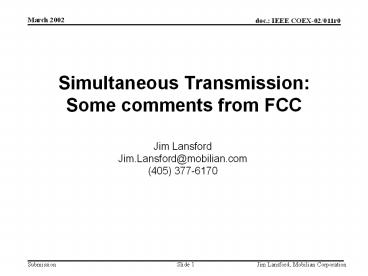Simultaneous Transmission: Some comments from FCC - PowerPoint PPT Presentation
Title:
Simultaneous Transmission: Some comments from FCC
Description:
Test results must be submitted to the FCC for review before an ... At the present time, TCBs are cleared to review SAR only for single-Tx Part 22, 24 handsets. ... – PowerPoint PPT presentation
Number of Views:20
Avg rating:3.0/5.0
Title: Simultaneous Transmission: Some comments from FCC
1
Simultaneous TransmissionSome comments from FCC
Jim Lansford Jim.Lansford_at_mobilian.com (405)
377-6170
2
Motivation
- Simultaneous Tx is a different view of
coexistence - Normally think of Tx-Rx coexistence
- Tx-Tx raises approval issues
- Some companies claim simultaneous Tx is not
allowed - This is meant to clarify
3
Presentation overview
- Dialog with Tim Harrington
- FCC Labs
- Equipment Authorization Branch
- Addresses approval issues for simultaneous Tx
- Dialog format is
- My question
- My assumed answer
- The FCCs response
4
Q1 Simultaneous Tx
- Lq1) Can 802.11b and Bluetooth transmit at the
same time in the same device? - La1) Yes, with restrictions. They must have
separate power amplifiers. If coupled to the
same antenna, the PA outputs can only be
passively combined (PA sharing is not allowed). - FCCa1) Yes for 802.11b and Bluetooth (BT).
Probably yes for 802.11b or BT with 802.11a.
Compliance with 15.31(k) for composite devices
must be addressed. La1 mentions use with same
antenna. In that case must address RF exposure
(RFx) and intermod from simultaneous Tx as
needed.
5
Q2 Authorization requirements
- Lq2) If so, are there special requirements for
equipment authorization for such devices? (SAR,
etc.) - La2) A device that does simultaneous transmission
must be tested to make sure it falls within SAR
limits for its intended usage. Thus, a TCB
cannot be used for equipment authorization. Test
results must be submitted to the FCC for review
before an FCCID will be granted. - FCCa2) Some considerations were listed in FCCa1.
Based on mobile or portable exposure conditions,
compliance should be evaluated to either MPE or
SAR limits. See attached notes for other
comments. At the present time, TCBs are cleared
to review SAR only for single-Tx Part 22, 24
handsets.
6
Q3 What is same device?
- Lq3) What is the definition of "same device?"
(For example, are radio modules on opposite ends
of a PC laptop considered to be in the same
device, even though they are 25 cm apart?) - La3) Same device isn't the issue - it's exposure
to RF energy from two or more sources. If a
laptop has two transmitters, overall exposure
from both combined at a pre-determined distance
(20cm?) is what matters. - FCCa3) Depending on powers and frequencies
(near-field effects), two Txs 20 cm apart on a
laptop computer can possibly be considered
separately, as long as mutual interactions are
negligible with respect to EMC and RFx. Mobile
phones with 1mW BT have been certified, as well
as laptops with 802.11b and BT. We have not seen
many 802.11a devices. For any Tx device, if
persons can approach closer than 20 cm,
compliance with SAR limits is required.
Depending on relative powers (levels TBD by FCC
we will consider industry suggestions), special
considerations are needed for RFx evaluation of
multi-Tx devices, including multi-band and probe
calibrations for simultaneous frequency-band
tests, and possible alternate on/off and on/on
testing for each Tx with summation of all RFx
responses in each applicable operating and
intermod frequency bands.
7
Q4 Antenna Spacing
- Lq4) If two transmitters are located on the same
IC or PCB, but have separate antennae, are they
considered to be the same device? Is this
dependent on antenna spacing? - La4) See La3. Two or more transmitters in the
same chip are allowed, but the device must still
meet the requirements of 15.247, 15.209, and
other relevant rules in all modes...especially
the SAR limits. - FCCa4) See also FCCa3. Per 15.31(k), each
separate Tx must meet its applicable rule parts.
For EMC and RFx testing, the devices should
transmit simultaneously, and emissions due to
simultaneous operation must not exceed limits for
the applicable rule parts of each separate Tx.
Depending on frequencies, aggregate power levels,
and exposure conditions, routine evaluation for
compliance with SAR limits is required when used
in portable configurations (2.1093). Two Tx on
one board can have one FCC ID, but for example a
15.247 device with a 15.407 device may require
application filing under two equipment classes
with two fees.
8
Q5Frequency band
- Lq5) Does it matter if the devices are in the
same frequency band (for example, Bluetooth and
GSM1900 are in different bands, while 802.11b and
Bluetooth share the 2.4GHz ISM band) - La5) Different band or same band doesn't matter -
again it's an issue of meeting harmonic and
spurious specifications as well as SAR limits. - FCCa5) No. Different bands may wind up having
different power thresholds. We agree with La5.
9
Summary
- FCC doesnt care if devices interfere
- But each needs to follow Part 15.247 restrictions
- Simultaneous Tx poses special approval issues
- Can potentially exceed SAR limits
- Cant use TCB program at present
- BUT
- FCC does allow simultaneous transmission































